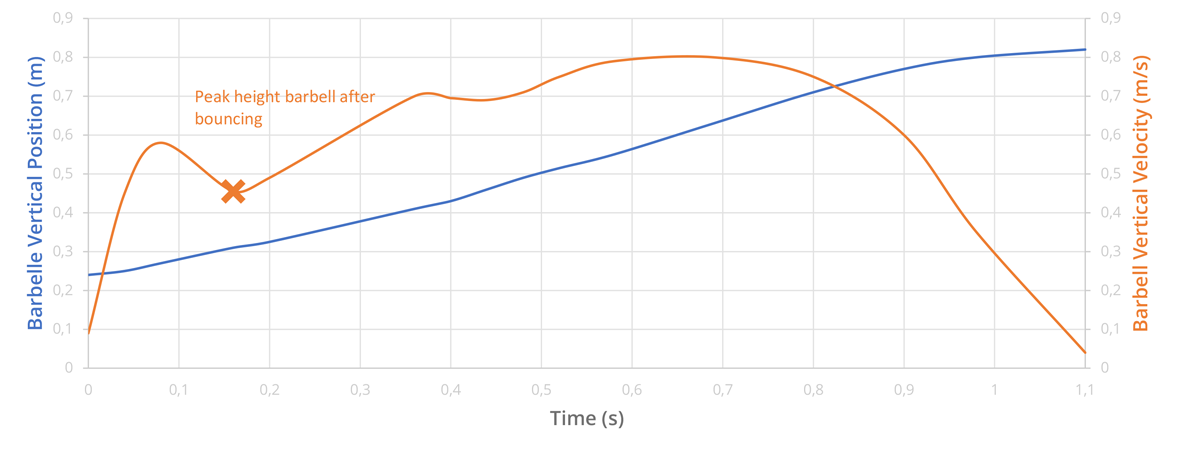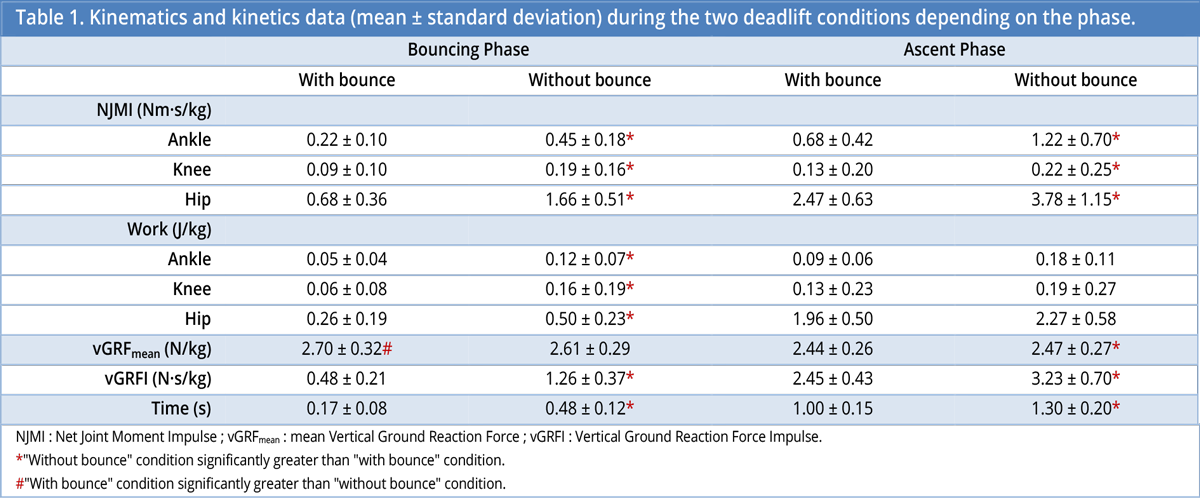
The deadlift is a polyarticular exercise and one of the three main movements in powerlifting. Hands on a loaded barbell resting on the ground, legs bent, the aim is to lift the load by extension of the ankles, knees, hip and lower back, until standing up, the bar held at arm's length against the body. Since the lifter is recruiting large muscle groups and the loads are important, it is one of the exercise generally include in many training programs designed to significantly increase the strength of the lower limbs, pelvic muscles, erector spinae, and muscle hypertrophy. It is also a highly recommended exercise for people suffering from mechanical back pain, who will benefit from improved endurance and muscle strength induced by this exercise in the posterior chain (read our article on this topic).
There are different variations of the deadlift : i) the traditional deadlift which consists of keeping the width of the feet stance equal to or less than the width of the shoulders ; (ii) the sumo deadlift where the feet stance is very much greater than the width of the shoulders in order to involve the adductors and the gracilis muscles and to reduce the mechanical work by decreasing the vertical displacement of the barbell ; and lastly, iii) the hexagonal barbell deadlift that aligns the center of mass of the body with that of the barbell, reducing shear forces in the lower back and increasing muscle action of the knee extensors (read our articles on the subject here et here). In addition to these variations, the way of performing the exercise and sequencing repetitions is also of great importance. In the gym, two styles appeared : the pause between each repetition with a zero barbell inertia with each new concentric phase and the bounce of the barbell on the ground making it possible to decrease the duration of a series and to potentially lift heavier. But what are the kinematic and kinetic impacts of this bounce in comparison to a complete pause between each repetition ?
To answer these questions, American researchers compared kinematic and kinetic parameters when performing a traditional deadlift with bounce of the barbell between each repetition and without bounce. For this, the researchers recruited 20 physically active men with deadlift experience (1RM = 165.8 ± 35.9) to whom they asked to perform one set of 5 repetitions at 75% 1RM in each condition.
The protocol consisted of two test sessions. In the first session, all participants evaluated their 1RM. In the second session, they performed two sets of 5 repetitions, one in each condition. To clearly assess the differences between these two ways of deadlifting, researchers used optoelectronic cameras (Vicon) and force plate for biomechanical analysis of the bouncing impact. The parameters used for the motion analysis were : the Net Joint Moment Impulse (NJMI) at the ankle, knee and hip, the work at the ankle, knee and hip, the average vertical ground reaction forces (vGRF) and the vertical ground reaction forces impulse. These parameters were studied during the bouncing phase (that is, between the contact of the barbell with the ground and a sudden decrease in the bar speed indicating the maximum height reached after the bounce, see Fig. 1) and the complete concentric phase. In addition, the articular angles of the ankle, knee and hip were measured at the maximum height reached by the barbell following the bounce. The bounce set was performed before the pause set in order to determine the height reached by the barbell thanks to the bounce to compare the two conditions on that particular moment.
The main results of this study show that during a set with bounce between each repetition, the different biomechanical parameters are significantly reduced during the initial concentric phase (ie, during the bouncing phase) and that the difference remains large over the entire concentric phase (Table 1). Indeed, the mechanical work, the net joint moment impulse, the vertical ground reaction forces impulse are significantly smaller when there is a barbell bounce on the ground. Only the average vertical ground reaction forces are larger during the bounce. This could be explained by the fact that the athlete must "catch" the barbell just after the bounce, when the bounce loses vertical speed, in order to continue raising the bar. The hip, knee and ankle joints being more flexed, indicate that muscle activation is not maximal at this time. Hence a greater muscular effort to prevent the barbell from going down, and to continue the upward movement. This means that for the same load, the bounce makes it possible to raise the bar with less effort, either during the specific bounce phase or over the entire concentric phase (which is confirmed by the measurements of rated perceived exertion (RPE) of participants in the study).

Figure 1. Position and speed of the barbell in deadlift during a repetition with bounce.
These results also show that the joints of the ankle and knee contribute less to rising the barbell during the bouncing condition. In practice, the bounce would thus place more emphasis on the hip extensors rather than the knee extensors. This is easily understandable since if the barbell is inert on the ground, the extensor muscles of the ankle and knee will have to work a lot more at the beginning of the movement to accelerate the weight, whereas in the case of the bounce, the bar will have already gained a certain amount of momentum when the athlete will actually starts to pull on it to continue the ascent, so the initial work on the ankle and knee will be greatly reduced.

This study demonstrates the impact of the bounce during a traditional deadlift on mechanical performance. It is easier to move a given load by using the bounce of the barbell on the ground between each repetition, than when it is systematically paused on the ground. Which means that with the bounce, it is possible to lift heavier. However, this approach implies that the force developed will not be proportional to the moved load, which means that the stimulus and the musculoskeletal adaptations will be smaller. In addition, the bounce induces a change in the muscular recruitment pattern of the deadlift, decreasing the role of the knee and ankle extensors to put more emphasis on the hip extensors.
Unfortunately, this study did not combine these measurements with electromyographic measurements to observe differences in muscle activation pattern with and without bounce of the barbell. In addition, it would be interesting to know if the technical placement of the athlete is not affected by the bounce at each repetition, and as fatigue ramps up during the set. The deadlift is a very intense exercise that requires a very strong and stable trunk, pelvis and scapular belt. Does the bounce alter this technical placement ? Can the athlete let the bar bounce while maintaining significant muscle tension ?
We remind you that you can quote articles by limiting your quotation to 200 words maximum and you must include a nominative link to this one. Any other use, especially copying in full on forum, website or any other content, is strictly prohibited. In doubt, contact us.
Copyright © 2011-2024 - www.sci-sport.com - All rights reserved